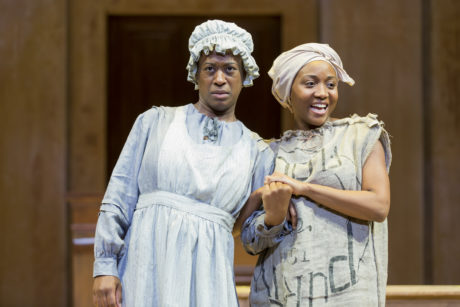Brandon Jacobs-Jenkins’s An Octoroon wears irony on its sleeve with the same effrontery that three of its characters wear red, white, and black greasepaint to dissemble “race.” Just opened at Woolly Mammoth, in a preconception-smashing production directed by Nataki Garrett, An Octoroon is among the most acclaimed recent works by playwrights of color that lampoon America’s endemic racism with disarming cheek and wit.
Theater is tailor-made for such cultural disruption; and as Jacobs-Jenkins demonstrated in Appropriate (which knocked me out when I saw it three seasons ago at Woolly), he’s a master at it. Dissimulation and discombobulation play on stage better than in any other art form. Scathing satire can say what’s serious far better than sermonizing. So why not send up race hate in the funnest way possible?
Nothing can’t be laughed at, right? Look at Mel Brooks’ “Springtime for Hitler.” Comedy can be cathartic. It speaks spoof to power.

An Octoroon’s mashup of performance styles is captured at Woolly with unerring flair. Among the production’s delightfully head-spinning attributes is the performance of Jon Hudson Odom in the prologue. Alone onstage in his underwear, Odom as BJJ enthralls with his comic turn mock-complaining to his prissy white therapist about the burden of being a black playwright. It’s a theme Jacobs-Jenkins struggles with personally and professionally. As he said in a recent interview:
I feel like I’m put in a position where I have to engage with what people bring to my work which is an expectation for me to talk about race because it’s not normal for a black writer to be writing in the theatre.
Odom jump-starts the show with Jacobs-Jenkins’s in-your-face response to that pigeonholing, which is to poke fun at it: Before long the actor is smearing on whiteface in preparation to play a plantation owner.
Introduced in a subsequent scene on said plantation in the roles of two slaves are Shannon Dorsey as Minnie and Erika Rose as Dido. The sight gag that starts the scene stops the show: Dido earnestly sweeping a floor clear of loose cotton while Minnie looks on lazily and eats a banana. Adding to the joke, the two speak in contemporary idiom. In one fell swoop, Jacobs-Jenkins sends up at least a half dozen racial stereotypes, and Dorsey and Rose as the sassy duo are stunningly funny.
Not only the acting but also the stage arts convey the play’s ironic insouciance. You can almost see air quotes hovering over, for instance, Micha Kachman’s flat false front of a plantation manse and Ivania Stack’s shapeless sackcloth costumes for the slaves and cartoonish day-glo formalwear for the plantation’s white elite.
The essence of irony—and why it suits Jacobs-Jenkins’s purpose and so pleases us—is that the surface meaning and the underlying meaning are not the same. There’s bait and switch, some entertaining misdirection from what really is being said. Thus there comes a scene in An Octoroon when the playwright lets us see what dead seriousness lies beneath.
As staged at Woolly, this big reveal feels even more stark and unsettling than the scene in Appropriate when we learned of a dysfunctional white Southern family’s ancestral complicity in lynching. Whereas in Appropriate the sobering disclosure functioned organically as a story engine, in An Octaroon, it’s just stuck in, like an inserted image from some other documentary-style play. It’s nothing like the playful and winking stuff that came before it, nothing like the playful and winking stuff that follows. It’s as if all those fiddledeedee air quotes are interrupted for a horrific OMG—and then keep fiddling as if nothing happened. But the moment comes as a shock to one’s system, like a stun gun to consciousness, and it burns into one’s brain.

In many ways An Octoroon seems cannily constructed as a “post-racial” divertissment—an entertaining evening in the theater that DC’s diverse audiences might equally enjoy. But there’s more up the sleeve upon which Jacobs-Jenkins wears that irony. In the same interview he said,
I wrestle with this idea of consensus in theatre all the time, where everyone’s supposed to feel the exact same thing together. But I’m interested in when we actually diverge on topics…
It’s in that uncompromising, stuck-in scene that what Woolly Mammoth’s radically entertaining An Octoroon “means” has nothing and everything to do with its audience’s race.
Running Time: 2 hours and 40 minutes, plus a 15-minute intermission.
An Octoroon plays through June 26, 2016 at Woolly Mammoth Theatre – 641 D Street, NW, in Washington, DC. For tickets, call the box office at (202) 393-3939, or purchase them online.
LINKS:
An Octoroon reviewed by David Gerson on DCMetroTheaterArts.
Spine: ‘An Octoroon,’ ‘The Octoroon’ at Woolly Mammoth Theatre Company by Robert Michael Oliver.





